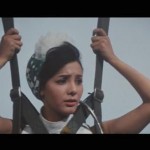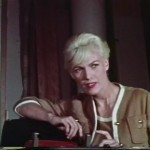Ironfinger 2: Golden Eye
aka 100発100中 黄金の眼 aka Hyappatsu hyakuchu: Ogon on me aka 100 Shot, 100 Killed: Golden Eye aka Booted Babe, Busted Boss

1968![]()
Written by Jun Fukuda, Ei Ogawa, and Michio Tsuzuki
Directed by Jun Fukuda

Ironfinger 2: Golden Eye returns to the world of Ironfinger. We have international criminals, jet setting fun, and a hero who is invincible kicking butt. As usual, the title changed for overseas export. 100 Shot, 100 Killed: Golden Eye became Ironfinger 2: Golden Eye, though in some locales it was turned into Booted Babe, Busted Boss! Those poor saps… The “Golden Eye” of the title betrays more of the Bond influence, for the few who couldn’t figure it out from the Ironfinger part, or for the Japanese audience. This is the last outing of Andrew Hoshino, so cry your tears now and then read all about it.

The tone is slightly altered in that Andrew Hoshino’s organization is hinted to be more criminal in nature, though Andrew himself is given a few more noble things to do. He’s pulled in under the story of avenging the murder of a Japanese citizen upon request of his young daughter. It turns into a quest to find the missing rare Samanta Gold coin, though that is just part of a bigger economic criminal conspiracy.
Golden Eye features world locations,Besides Japan, the opening of the film is in Beirut! This may seem amazing to modern audiences that anyone would spend time in Beirut, but things weren’t always the way they are now. Another thing Ironfinger 2 has is sheiks in blackface (also seen in Yellow Line). The characters are played by Japanese actors, but are painted up dark brown and treated as if they’re foreign. Both a good police officer and several of the villains feature this treatment. Also both of the Ironfinger films feature big boss villains who are Caucasian, though both are European in origin. I would guess this is to show both that the Japanese hero can defeat anyone in the world, including what would be considered traditional Bond villains, and that Japanese people can’t be the big villain because they aren’t evil, and it’s people outside their culture affecting their life.
A highlight of these Ironfinger films is the killer 1960s clothing. Every outfit Bibari Maeda wears is spectacular. The cool clothes help make the fun lifestyle easier to accept, as they’re dressed just like cool people, so they would naturally do cool things.

Andrew Hoshino has a pair of women to deal with, though his darker affiliation is reveal again as bad girl Ruby is who he is paired with the most, Mistuko Saito functions as a catalyst to get the plot to the various locations, but she’s far too busy being a star to drop everything to run around with a playboy spy. Freelance bad girl Ruby easily slips into this role, her various connections with Andrew happening frequently
The far more complicated plot deals with economic problems of late 1960s Japan, hidden treasure, and even a hint of environmentalism thrown in. The whole thing hinges on a missing rare gold coin, but the real crime is wholesale precious metals smuggling used to hold hostage parts of Japan’s economy. It seems like it should be a modern film, the economic battle having played out in a modified form in real life. Golden Eye thankfully just uses that as backdrop and keeps the focus on the missing rare coin, giving audiences who don’t understand complex economic issues something to follow, while those who are aware have an insight into why the villains have so many high powered goons.

|

The women are different characters than in the original. Mitsuko is given a bomb to give to Andrew, but is not an explosives expert (or even a criminal!), unlike Mie Hama’s Yumi Sawada from the original. Ruby is a closer analogue, a hip contract player, though she’s more of a knife expert and information broker and plays multiple angles. She’s also willing to betray left and right to get to the big score. However, the awesome power of Andrew Hoshino is enough to turn her loyal. Because he’s just that cool. That’s the bigger problem with the characters, Ruby buys into Andrew’s awesomeness, though at least spends a good deal of the film doing her own tightrope walking, it just keeps running into Andrew.
Andrew is introduced in all red, doing trick shots at a shooting gallery and winning a huge prize, that he gives away to the girls young girl he sees. Despite wearing a hat in this scene, the hat running joke has died and he spends this film largely unadorned on his crown. The constantly being captured joke returns, and Andrew will get caught time and time again. Even his partners get captured a lot independent of him.
Detective Tezuka returns, played by a new actor and now part of an international police force. He’s also done some research into who Andrew works for, but also welcomes his involvement in what turns out to be a big conspiracy case.
Golden Eye is filled with crazy sequences like the original featured. The most notable is when a group of assassins, who are all garbed in Muslim women attire and pushing baby strollers, whip out machine guns and open fire at our heroes in a quarry. The only way to defeat lots of machine gun welding thugs? Throw machine guns at them, and shoot those machine guns so they start firing their bullets, which will hit the guys at the top of a cliff and kill them. This actually happens.
The trick used during the final big gun battle involving champagne is less ridiculous, but still crazy. This plays opposite of the final gun duel, between Andrew and Stonefeller. Stonefeller is blind, but has a huge microphone on his gun, allowing him to hear where his enemies are. This forces Andrew to be stone silent, dropping a huge amount of suspense on the final outcome.


Golden Eye follows the trend of not taking itself seriously. It features a Fuel Economy Rally — yes, driving cars to save fuel. The opening sequence is a man being hooked by a grappling hook dangling from a helicopter. At one point Andrew is wrapped up in a body cast by the villains so he can’t escape. He does.
The fun is occasionally broken by serious bits, such as the aforementioned silent final duel. Before that, Andrew once again gives a bad guy the opportunity to escape if he wasn’t such a good shot. As this villain spends the previous scene begging for his lift, there is a bit more impact. There is also a torture sequence where Stonefeller’s men uses a car cigarette lighter as a torture device on the two women characters.
Though Bibari Maeda is her amazing charming self, her character is custom designed to end up with Andrew, and suffers development as a result. Tomomi Sawa’s Mitsuko Saito instead is more rounded, her quest for singing fame, environmental activism, and staying in the public eye (thus using a framing of Andrew for murder as a way to gain fame for herself) help Mistuko seem more real. Both women end up getting captured and tortured until Andrew rescues them. It is a Bondian spy film, after all.
While the first Ironfinger was having too much fun to realize how much it was lampooning James Bond, Golden Eye seems more aware, and also more aware that it needs to throw in a bit more realistic danger. The movie tone grows slightly off-kilter, while no one believes that Andrew Hoshino is ever in any realistic danger. The element of fun is still there, the period look and feel is accurate, and Ironfinger 2 sits on the same platform as its predecessor. Fun, but not big enough to say enough of importance to matter. The celebratory trip to Vegas at the end seems like an obligation, and the Ironfinger franchise ended up staying in Vegas, ending here.


Rated 7/10 (The Client, the fake, the real, the fired employee, music video, totally a real lighter, Mr. Microphone)
Please give feedback below!




























2 Comments
Tyler
September 28, 2013 at 4:02 amSo these are on criterions website? Hope that means a DVD realised in the works
Tars Tarkas
September 28, 2013 at 11:03 amThey are both through Hulu Plus, which Criterion partnered with and has 800 some movies online. They do rotate films into the free part, but I haven’t heard anything about DVDs yet.